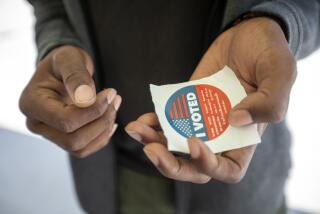A Challenging Election Day
- Share via
California’s first effort to recall a governor has been anything but routine, from the huge and eclectic field of candidates eager to replace Gov. Gray Davis to a series of lawsuits that sought to postpone the election. Only last week could anyone even be sure the Oct. 7 election would be held.
As the campaign rolls into its final days, about the only thing voters can count on is finding a few more kinks in the system on election day.
“Everything about this is abnormal,” said Angela Burrell, spokeswoman for the Orange County registrar of voters.
For starters, millions of Californians won’t be casting ballots at the same place they used last year. It remains unclear how many of them realize this -- to the trepidation of election officials up and down the state.
California’s 58 counties had less than three months to prepare for the vote. On July 23 the secretary of state certified that recall petitioners had collected enough signatures to force an election, which had to be held within 80 days.
Because of the time crunch, county registrars consolidated thousands of precincts so they could stage the election with fewer polling places and workers than usual.
In Los Angeles County, Registrar-Recorder Conny B. McCormack compressed about 4,900 regular precincts into 1,786 for the recall. The county stamped a large red-and-blue “voter alert” message on the front of the sample ballots mailed to 4 million registered voters, warning them to check the back cover to see whether their polling places had changed.
McCormack’s office also has mailed signs and maps to more than 3,000 polling places that aren’t being used this time, asking them to post the materials to guide stray voters to the proper locations. Orange County, which condensed about 1,700 polling places into 476, plans to do the same. Other Southern California counties such as Riverside have decided not to post extra signs, relying on voters to review the ballot ahead of time.
“Check your sample ballot. Mark it so that you can find your candidate,” advised Mischelle Townsend, the Riverside County registrar. “We’ve experienced great momentum and enthusiasm for this election, and we want to maintain that.”
Some voters, however, already have flagged potential problems. Joan Leonard of Sherman Oaks made a dry run to check out her new polling place -- a storefront tucked beside a freeway offramp -- and had trouble finding the driveway. When she did get in, she saw there were only six parking spaces to accommodate the 2,600 voters in her precinct.
“It’s really a loser location,” she said. “If every poll was picked the way this one was, it’s probably going to be a real fiasco.”
After Leonard alerted the registrar’s office, election officials secured a few more spaces.
When people arrive at their polling place, they should be prepared for more surprises. In sleepier races, they might show up at the local elementary school gym to cast a ballot and find no other voters in sight -- only a row of bored poll workers.
But in this election, with fewer polling places and experts predicting a large turnout, voters may have to wait in line for 10 to 20 minutes, particularly during the morning and evening rush hours. The polls will be open from 7 a.m. to 8 p.m., and state law requires election workers to allow everyone already in line at closing time to cast a vote.
The Ballot
The October ballot poses just four questions, two involving the recall and two on other measures.
The first question is the recall itself: “Shall Gray Davis be recalled (removed) from the office of governor?”
Voters can choose yes or no, or skip the question. Whichever they decide, they can still cast a vote on the next matter: Who will replace Davis if he is recalled. He needs a majority vote to stay in office.
There will be 135 candidates listed as possible successors. Davis does not appear as a choice because he cannot run to replace himself.
The long list concerns some election officials, who worry that people may have trouble finding their candidate or may accidentally vote for more than one person. The candidates’ names appear in no apparent order. They were arranged based on a lottery of randomly selected letters that created an odd alphabet in which names beginning with R will be followed by those starting with W, Q, O and so on. Even within a group of names beginning with the same letter, they are arranged in this order.
State law requires that the ballot order rotate throughout the state’s 80 Assembly districts, so that the candidate listed first in District 1 drops to the bottom of the list in District 2, bumping the others up one notch.
All of which keeps things fairly even among the candidates, so that no one is always at the top or bottom of the bottom among the candidates. Arnold Schwarzenegger’s name won’t leap off the page any more than those of ballot-mates Lawrence Steven Strauss, a Sherman Oaks lawyer who studies aviation at Glendale Community College, and George B. Schwartzman, the San Diego owner of a medical firm that treats urological diseases. But it also means a voter should read the sample ballot carefully to find a favored candidates before stepping into the voting booth. Registrars say this will save time and -- they hope -- reduce the number of votes that must be disqualified because someone voted for more than one candidate.
Also on the ballot are two statewide measures. Proposition 53 would dedicate up to 3% of California’s general fund revenues each year to infrastructure projects such as roads. Proposition 54 would bar the state and local governments from collecting and using most kinds of racial and ethnic data.
The sheer size of the gubernatorial candidate list has complicated efforts to display all the choices. Some counties, such as Orange and San Bernardino, have resorted to using 17-inch-long ballots to fit all the names.
In Los Angeles County, voters will have to flip through seven pages in their laminated ballot book to find their chosen candidate and then poke the corresponding hole on their punch-card ballot. In Ventura County, voters will be handed seven ballot cards, mostly filled with candidates’ names.
Each of the five Southern California counties has a different voting system. In Los Angeles County (and five other counties statewide), the decision to use the outdated punch-card ballots prompted a federal lawsuit by the American Civil Liberties Union, which temporarily halted plans for the election. On Tuesday, the U.S. 9th Circuit Court of Appeals ruled that the election should go on as scheduled.Ventura County also will use a punch-card system, but not the same kind used in Los Angeles.
In Ventura, voters will indicate their choices by pulling the lever on a metal machine that drives a rectangular hole through the ballot card. The cards are not pre-scored, so chads -- hanging, pregnant and otherwise -- are not an issue, said Bruce Bradley, Ventura County’s assistant registrar.
Riverside County uses perhaps the most modern system: touch-screen voting. The county’s 646,000 registered voters have been using the system since 2000, so election officials do not anticipate any problems.
“We have so many elections here. There’s one practically every month,” Townsend said.
In San Bernardino County, voters will use a new system of large ballot cards with the candidates’ names printed on both sides. To cast a vote, they will draw a line that forms an arrow pointing toward the desired choice.
“It’s really intuitive,” said Registrar Scott Konopasek. “When they see it, they’ll understand it.”
But just in case they don’t, the county plans to post signs in voting booths explaining the new method.
Orange County also is trying out a large paper ballot, an even bigger version than the one in San Bernardino. All the questions and candidates fit on one side of the 11- by 17-inch sheet, and voters will indicate their choices by darkening tiny rectangles with ink.
Counting the Vote
Voter turnout is notoriously hard to predict. Still, election officials note that they have been deluged with requests for absentee ballots, suggesting strong voter interest.
Taken together, the five counties in the metropolitan region reported having mailed out nearly 1 million absentee ballots by mid-September, representing about 14% of registered voters in the area.
More than 200,000 have already been sent back but the return rate abruptly slowed after the court temporarily postponed the election.As usual, election workers plan to post unofficial results election night, starting with unofficial absentee vote counts available soon after the polls close. The numbers will be updated as various precincts are processed.
But in this election, the initial tally could be delayed in some counties. In San Bernardino County, for example, election officials bought only enough counting machines to handle this election because they plan to switch soon to another voting system.
By the morning of Oct. 8, hundreds of thousands of votes will remain uncounted across the state.
Those that cannot be processed immediately will include absentee ballots that are turned in at the polls, ballots containing write-in votes, and provisional ballots (used when a voter’s registration is questioned or when the voter already has been sent an absentee ballot). All will require further review before they can be counted.
In Los Angeles County alone, officials estimate that 100,000 to 200,000 ballots will fall into these categories -- potentially enough to decide a race. State law allows election workers 28 days to complete the final, official count. Counties then will have another week to forward the results to the state.
The secretary of state has four days then to certify the election.
*
(BEGIN TEXT OF INFOBOX)
Whens, wheres
Dates to Remember
Tuesday -- Last day to request an absentee ballot.
Oct. 7 -- Election day. Absentee ballots must be delivered to county registrar’s office by this date, either by mail or in person.
Nov. 11-- Deadline for counties to submit final election results to state. Once the results are official, the secretary of state will certify the election.
Nov. 15 -- Deadline for secretary of state to certify election. If Davis is recalled, the new governor will take office after the certification
Contact Information
California Secretary of State
1500 11th St.
Sacramento, CA 95814
(916) 653-6814
www.ss.ca.gov
www.myvotecounts.org
Los Angeles County Registrar-Recorder/County Clerk
12400 Imperial Highway
Norwalk, CA 90650
(562) 462-2748
Hours: 8 a.m. to 5 p.m.
regrec.co.la.ca.us/
Orange County Registrar of Voters
1300 S. Grand Ave., Building C
Santa Ana, CA 92705
(714) 567-7600
Hours: 8 a.m. to 5 p.m.
www.oc.ca.gov/election/
Riverside County Registrar of Voters
2724 Gateway Drive
Riverside, CA 92507-0918
(909) 486-7200
Hours: 8 a.m. to 5 p.m.
www.voteinfo.net
San Bernardino County Registrar of Voters
777 E. Rialto Ave.
San Bernardino, CA 92415-0770
(909) 387-8300
Hours: 8 a.m. to 5 p.m.
www.sbcrov.com
Ventura County Clerk-Recorder-Registrar of Voters
800 S. Victoria Ave.
Ventura, CA 93009-1200
(805) 654-2664
Hours: 8 a.m. to 5 p.m.
www.ventura.org/election/elecidx.htm
Early Touch-Screen Voting
Los Angeles and Riverside counties: In Los Angeles County, voters can cast their ballots early on touch-screen machines stationed at 11 locations through Friday and at the registrar’s Norwalk headquarters through election day. In Riverside County, voters can cast their ballots early on touch-screen machines at three locations through Saturday and at the registrar’s Riverside headquarters through election day. Call the respective county registrars for locations.
Los Angeles Times
More to Read
Get the L.A. Times Politics newsletter
Deeply reported insights into legislation, politics and policy from Sacramento, Washington and beyond. In your inbox twice per week.
You may occasionally receive promotional content from the Los Angeles Times.










